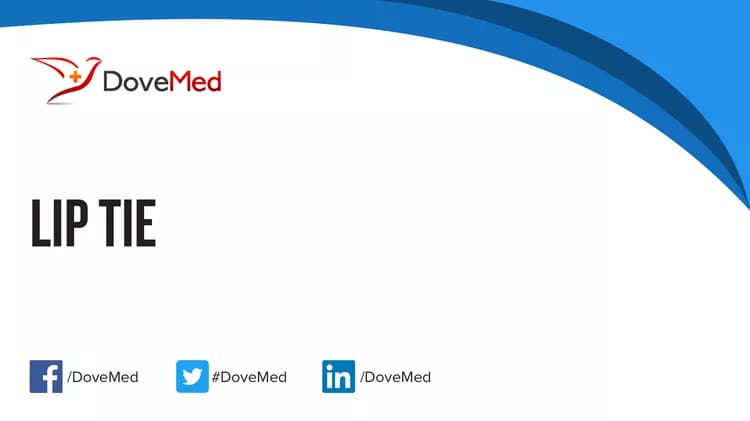What are the other Names for this Condition? (Also known as/Synonyms)
- Lip Adhesion
- Lip-Tie
What is Lip Tie? (Definition/Background Information)
- Lip Tie is a congenital condition wherein the presence of an abnormal frenum, between the lip and front teeth mostly in the upper jaw, may result in pain, eating or speaking difficulties, or even cause the gums to recede. It is a common condition that is correctable through surgery, when needed
- The frenum or frenulum is a fibro-muscular tissue that is present at various body sites, such as below the tongue (called lingual frenulum), below the lip (labial frenulum), inside the cheek (buccal frenulum), or in the genitalia (genital frenulum)
- Lip Tie occurs due to an abnormal growth during fetal development. The severity of the condition can vary from mild to severe. It can result in complications that include higher risk for dental health issues and infections, due to poor breastfeeding
- The treatment measures for Lip Tie may include a labial frenectomy; a surgical procedure to remove the abnormal frenulum. In some cases, the healthcare provider may undertake a watchful waiting approach, to see how the condition progresses. With adequate treatment, the prognosis is usually excellent
Who gets Lip Tie? (Age and Sex Distribution)
- Lip Tie is typically diagnosed in infants and young children; although, it may be diagnosed later during adulthood too
- Both males and females are affected
- Racial, ethnic, or geographical predominance is not observed
What are the Risk Factors for Lip Tie? (Predisposing Factors)
- A positive family history of the condition may be a risk factor for Lip Tie
- No other risk factors have been clearly identified
It is important to note that having a risk factor does not mean that one will get the condition. A risk factor increases one’s chances of getting a condition compared to an individual without the risk factors. Some risk factors are more important than others.
Also, not having a risk factor does not mean that an individual will not get the condition. It is always important to discuss the effect of risk factors with your healthcare provider.
What are the Causes of Lip Tie? (Etiology)
- The exact cause of development of Lip Tie is not well-established
- However, it is believed that the detachment/separation of the frenulum does not take place normally during fetal development, resulting in a Lip Tie
What are the Signs and Symptoms of Lip Tie?
The signs and symptoms of Lip Tie may include:
- Difficulties in brushing and flossing one’s teeth; food debris get trapped in between the lip and jaw resulting in plaque and tartar deposition
- The gums recede to expose more teeth; the presence of excess frenulum tissue in the upper lip can also cause a large gap between the two upper incisors, at onset of permanent teeth
- Chewing and eating difficulties
- Speaking difficulties
- Difficulty in breastfeeding (for both the baby and the mother), which can increase the child’s susceptibility to infections
- Bad breath
- Difficulty in wearing dentures or fitting braces; the dentures are getting frequently dislodged
- The condition causes obstruction to certain orthodontic procedures or placement of oral prosthetic devices
The symptoms vary according to severity of the abnormal tissue growth. Excessive frenulum growth can cause more severe symptoms than a milder case of Lip Tie.
How is Lip Tie Diagnosed?
Lip Tie may be diagnosed using the following methods:
- A complete physical and oral examination (examination of the mouth). In many cases, an oral exam is sufficient to establish a diagnosis
- Assessment of medical history including the presence of any underlying conditions, family history, etc.
Many clinical conditions may have similar signs and symptoms. Your healthcare provider may perform additional tests to rule out other clinical conditions to arrive at a definitive diagnosis.
What are the possible Complications of Lip Tie?
Complications due to Lip Tie may include:
- Breastfeeding difficulties can cause increased susceptibility to infections
- Low weight gain in infants and babies
- The condition can accelerate dental decay such as gingivitis and periodontal disease
- Cosmetic issues
- Complications that result from the surgical procedures used to treat the condition
How is Lip Tie Treated?
The treatment for Lip Tie may include:
- A ‘wait and watch’ approach may be undertaken by the healthcare provider for mild cases
- A surgical correction of the condition, called labial frenectomy, may be performed for severe cases. Any of the following techniques may be employed:
- Conventional scalpel method (surgical knife method)
- Soft-tissue laser surgery
- Electrocautery or thermal cautery
It has been noted than in some rare cases, the condition resolves on its own.
How can Lip Tie be Prevented?
Currently, there are no available measures to prevent Lip Tie. However, if it is associated with a genetic disorder, then the following may be considered:
- Genetic testing of the expecting parents (and related family members) and prenatal diagnosis (molecular testing of the fetus during pregnancy) may help in understanding the risks better during pregnancy
- If there is a family history of the condition, then genetic counseling will help assess risks, before planning for a child
- Active research is currently being performed to explore the possibilities for treatment and prevention of inherited and acquired genetic disorders
What is the Prognosis of Lip Tie? (Outcomes/Resolutions)
The prognosis of Lip Tie is generally excellent with appropriate treatment (including surgery).
Additional and Relevant Useful Information for Lip Tie:
Please visit our Dental Health Center for more physician-approved health information:
Related Articles
Test Your Knowledge
Asked by users
Related Centers
Related Specialties
Related Physicians
Related Procedures
Related Resources
Join DoveHubs
and connect with fellow professionals


0 Comments
Please log in to post a comment.